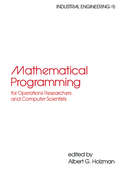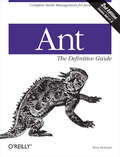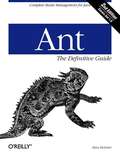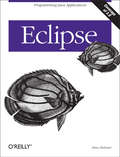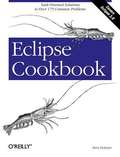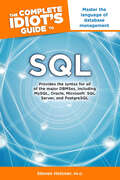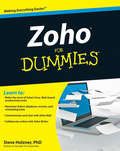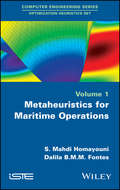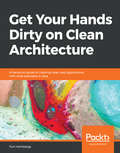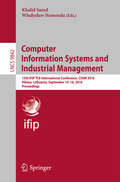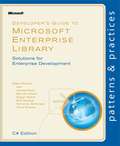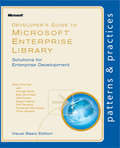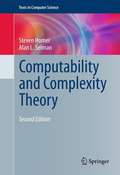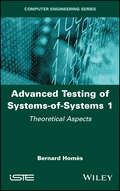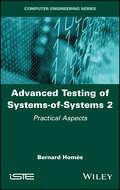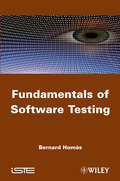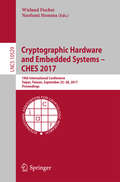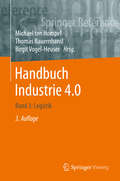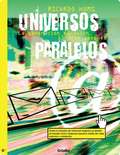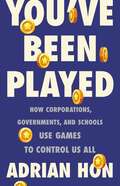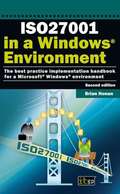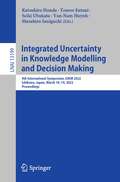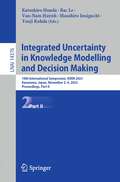- Table View
- List View
Mathematical Programming for Operations Researchers and Computer Scientists
by Albert G. HolzmanThis book covers the fundamentals of linear programming, extension of linear programming to discrete optimization methods, multi-objective functions, quadratic programming, geometric programming, and classical calculus methods for solving nonlinear programming problems.
Ant: The Definitive Guide
by Steve HolznerSoon after its launch, Ant succeeded in taking the Java world by storm, becoming the most widely used tool for building applications in Java environments. Like most popular technologies, Ant quickly went through a series of early revision cycles. With each new version, more functionality was added, and more complexity was introduced. Ant evolved from a simple-to-learn build tool into a full-fledged testing and deployment environment. Ant: The Definitive Guide has been reworked, revised and expanded upon to reflect this evolution. It documents the new ways that Ant is being applied, as well as the array of optional tasks that Ant supports. In fact, this new second edition covers everything about this extraordinary build management tool from downloading and installing, to using Ant to test code. Here are just of a few of the features you'll find detailed in this comprehensive, must-have guide: Developing conditional builds, and handling error conditions Automatically retrieving source code from version control systems Using Ant with XML files Using Ant with JavaServer Pages to build Web applications Using Ant with Enterprise JavaBeans to build enterprise applications Far exceeding its predecessor in terms of information and detail, Ant: The Definitive Guide, 2nd Edition is a must-have for Java developers unfamiliar with the latest advancements in Ant technology. With this book at your side, you'll soon be up to speed on the premiere tool for cross-platform development. Author Steve Holzner is an award-winning author who s been writing about Java topics since the language first appeared; his books have sold more than 1.5 million copies worldwide.
Ant: The Definitive Guide, 2nd Edition
by Steve HolznerAs the most widely used tool for cross-platform development, Ant has undergone a number of important changes in its functionality and use since its launch. Ant: The Definitive Guide , 2nd Edition has been reworked to reflect these changes for Java developers everywhere. Topics covered include everything from downloading and installing, to using Ant to build Web applications, to using Ant to test code.
Ant: The Definitive Guide, 2nd Edition
by Steve HolznerSoon after its launch, Ant succeeded in taking the Java world by storm, becoming the most widely used tool for building applications in Java environments. Like most popular technologies, Ant quickly went through a series of early revision cycles. With each new version, more functionality was added, and more complexity was introduced. Ant evolved from a simple-to-learn build tool into a full-fledged testing and deployment environment. Ant: The Definitive Guide has been reworked, revised and expanded upon to reflect this evolution. It documents the new ways that Ant is being applied, as well as the array of optional tasks that Ant supports. In fact, this new second edition covers everything about this extraordinary build management tool from downloading and installing, to using Ant to test code. Here are just of a few of the features you'll find detailed in this comprehensive, must-have guide: Developing conditional builds, and handling error conditions Automatically retrieving source code from version control systems Using Ant with XML files Using Ant with JavaServer Pages to build Web applications Using Ant with Enterprise JavaBeans to build enterprise applications Far exceeding its predecessor in terms of information and detail, Ant: The Definitive Guide , 2nd Edition is a must-have for Java developers unfamiliar with the latest advancements in Ant technology. With this book at your side, you'll soon be up to speed on the premiere tool for cross-platform development. Author Steve Holzner is an award-winning author who s been writing about Java topics since the language first appeared; his books have sold more than 1.5 million copies worldwide.
Eclipse
by Steve HolznerJava programmers know how finicky Java can be to work with. An omitted semi-colon or the slightest typo will cause the Java command-line compiler to spew pages of annoying error messages across your screen. And it doesn't fix them--that's up to you: fix them, compile again, and hope that nothing goes wrong this time. Eclipse, the popular Java integrated development environment (IDE) provides an elegant and powerful remedy for this common, frustrating scenario. It doesn't just catch your errors before you compile, it also suggests solutions. All you need to do is point and click. And it's free--what could be better? Still, if you're like most programmers, mastering a new technology--no matter how productive it will make you in the long run--is going to take a chunk out of your productivity now. You want to get up to speed quickly without sacrificing efficiency. O'Reilly's new guide to the technology, Eclipse, provides exactly what you're looking for: a fast-track approach to mastery of Eclipse. This insightful, hands-on book delivers clear and concise coverage, with no fluff, that gets down to business immediately. The book is tightly focused, covering all aspects of Eclipse: the menus, preferences, views, perspectives, editors, team and debugging techniques, and how they're used every day by thousands of developers. Development of practical skills is emphasized with dozens of examples presented throughout the book. From cover-to-cover, the book is pure Eclipse, covering hundreds of techniques beginning with the most basic Java development through creating your own plug-in editors for the Eclipse environment. Some of the topics you'll learn about include:Using Eclipse to develop Java code Testing and debugging Working in teams using CVS Building Eclipse projects using Ant The Standard Widget Toolkit (SWT) Web development Developing Struts applications with Eclipse From basics to advanced topics, Eclipse takes you through the fundamentals of Eclipse and more. You may be an Eclipse novice when you pick up the book, but you'll be a pro by the time you've finished.
Eclipse Cookbook
by Steve HolznerYou've probably heard the buzz about Eclipse, the powerful open source platform that gives Java developers a new way to approach development projects. It's like a shiny new car--no longer content to just admire Eclipse, you're now itching to get in and drive. Eclipse is to Java developers what Visual Studio is to .NET developers--it's an integrated development environment (IDE) that combines a code editor, compiler, debugger, text editor, graphical user interface (GUI) builder, and other components into a single, user-friendly application. It provides a solid foundation that enables Java developers to construct and run integrated software-development tools for web development, application design, modeling, performance, testing, and much more. As with any extensive programming tool, however, there's a lot to learn. And there s no better guy than well-known Java expert Steve Holzner to teach you. An award-winning and best-selling author who has been writing about Java topics since the language first appeared, Holzner delivers just the kind of targeted, practical, everyday knowledge you need to hone your mastery of Eclipse. Perfect as a companion to an Eclipse programming tutorial (such as Holzner's own Eclipse , O'Reilly, April 2004) or an ideal stand-alone for all those developers who either don't want or don't need the tutorial approach, the Eclipse Cookbook contains task-oriented recipes for more than 800 situations you may encounter while using this new Java platform--from deploying a web application automatically to reverse engineering compiled code, from re-naming all references to a class across multiple packages to initializing the SWT JNI libraries. Each recipe in the ever-popular and utterly practical problem-solution-discussion format for O'Reilly cookbooks contains a clear and thorough description of the problem, a brief but complete discussion of a solution, and in-action examples illustrating that solution. The Eclipse Cookbook will satiate Java programmers at all levels who are ready to go beyond tutorials--far beyond writing plug-ins and extensions--and actually use the powerful and convenient Eclipse day to day.
Ant: The Definitive Guide, 2nd Edition
by Steven HolznerAs the most widely used tool for cross-platform development, Ant has undergone a number of important changes in its functionality and use since its launch. Ant: The Definitive Guide , 2nd Edition has been reworked to reflect these changes for Java developers everywhere. Topics covered include everything from downloading and installing, to using Ant to build Web applications, to using Ant to test code.
The Complete Idiot's Guide to SQL: Master the Language of Database Management
by Steven Holzner• Provides a practical overview of the most common database management tasks for those who need to manage data
Zoho For Dummies
by Steven HolznerA great way to get started on this new, FREE, Web-based productivity and collaboration toolZoho is a very cool-and free-alternative to Microsoft Office. Known as "cloud" computing because it's totally Web-based, Zoho provides 18 different applications to help you write documents, create spreadsheets, send e-mail, and much more. People love it, but what it doesn't offer are extensive help files, so that's where this practical book comes in.Zoho For Dummies shows you how to use Zoho's most widely used applications, including Zoho Writer, Zoho Notebook, Zoho Show, Zoho Sheet, Zoho DB, Zoho Mail, Zoho Planner, Zoho CRM, and Zoho Projects. You'll get thoroughly up to speed on all common tasks and discover enough tips and tricks to get you power-using Zoho in no time.Zoho is a free, Web-based alternative to Microsoft Office launched in 2007; it is considered to be "cloud computing" because it is categorized as Software as a Service (SaaS) and Web-basedThe book guides you through common tasks and provides tips and tricks to maximize your productivity and minimize hassleCovers Zoho Writer, Zoho Notebook, Zoho Show, Zoho Sheet, Zoho DB, Zoho Mail, Zoho Planner, Zoho CRM, and Zoho ProjectsAlso provides information about sharing content, scheduling, and moreGet your head in the clouds with this friendly guide to the exciting new Zoho "cloud" alternative to Microsoft Office.
Metaheuristics for Maritime Operations
by S. Mahdi Homayouni Dalila B.M.M. FontesMetaheuristic Algorithms in Maritime Operations Optimization focuses on the seaside and port side problems regarding the maritime transportation. The book reviews and introduces the most important problems regarding the shipping network design, long-term and short-term scheduling and planning problems in both bulk and container shipping as well as liquid maritime transportation. Application of meta heuristic algorithm is important for these problems, as most of them are hard and time-consuming to be solved optimally.
Get Your Hands Dirty on Clean Architecture: A hands-on guide to creating clean web applications with code examples in Java
by Tom HombergsGain insight into how hexagonal architecture can help to keep the cost of development low over the complete lifetime of an application Key Features Explore ways to make your software flexible, extensible, and adaptable Learn new concepts that you can easily blend with your own software development style Develop the mindset of building maintainable solutions instead of taking shortcuts Book Description We would all like to build software architecture that yields adaptable and flexible software with low development costs. But, unreasonable deadlines and shortcuts make it very hard to create such an architecture. Get Your Hands Dirty on Clean Architecture starts with a discussion about the conventional layered architecture style and its disadvantages. It also talks about the advantages of the domain-centric architecture styles of Robert C. Martin's Clean Architecture and Alistair Cockburn's Hexagonal Architecture. Then, the book dives into hands-on chapters that show you how to manifest a hexagonal architecture in actual code. You'll learn in detail about different mapping strategies between the layers of a hexagonal architecture and see how to assemble the architecture elements into an application. The later chapters demonstrate how to enforce architecture boundaries. You'll also learn what shortcuts produce what types of technical debt and how, sometimes, it is a good idea to willingly take on those debts. After reading this book, you'll have all the knowledge you need to create applications using the hexagonal architecture style of web development. What you will learn Identify potential shortcomings of using a layered architecture Apply methods to enforce architecture boundaries Find out how potential shortcuts can affect the software architecture Produce arguments for when to use which style of architecture Structure your code according to the architecture Apply various types of tests that will cover each element of the architecture Who this book is for This book is for you if you care about the architecture of the software you are building. To get the most out of this book, you must have some experience with web development. The code examples in this book are in Java. If you are not a Java programmer but can read object-oriented code in other languages, you will be fine. In the few places where Java or framework specifics are needed, they are thoroughly explained.
Computer Information Systems and Industrial Management: 15th IFIP TC8 International Conference, CISIM 2016, Vilnius, Lithuania, September 14-16, 2016, Proceedings (Lecture Notes in Computer Science #9842)
by Władysław Homenda Khalid SaeedThis book constitutes the refereed proceedings of the 11th International Conference on Computer Information Systems and Industrial Management, CISIM 2012, held in Venice, Italy, in September 2012. The 35 revised full papers presented together with 2 keynote talks were carefully reviewed and selected from 80 submissions. The papers are organized in topical sections on security, access control and intrusion detection; pattern recognition and image processing; biometric applications; algorithms and data management; networking; and system models and risk assessment.
Developer's Guide to Microsoft® Enterprise Library, C# Edition
by Alex Homer Nicolas Botto Bob Brumfield Grigori Melnik Erik Renaud Fernando Simonazzi Chris TavaresWelcome to the era of software reuse! Microsoft Enterprise Library helps accelerate development by providing reusable components and guidance on proven practices. If you build applications that run on the Microsoft .NET Framework, whether they are enterprise-level business applications or even relatively modest Windows® Forms, Windows Presentation Foundation (WPF), Windows Communication Foundation (WCF), or ASP.NET applications, you can benefit from using Enterprise Library. This guide helps you to quickly grasp what Enterprise Library can do for you, presents examples, and makes it easier for you to start experimenting with Enterprise Library. Enterprise Library is made up of a series of application blocks, each aimed at managing specific cross-cutting concerns. The guide will walk you through the most common usage scenarios for each of the functional application blocks, including:Improving performance by utilizing a local in-memory or isolated storage cache. Calling into your database stored procedures and managing the results exposed as a sequence of objects for client side querying. Incorporating cryptography mechanisms to protect your data. Designing and implementing a consistent strategy for managing exceptions that occur in various architectural layers of your application. Implementing system logging through the wide variety of out-of-the box logging sinks or your custom provider. Performing structured and easy-to-maintain validation using attributes and rules sets. The guide also demonstrates various ways of configuring Enterprise Library blocks. Let Enterprise Library do the heavy lifting for you and spend more time focusing on your business logic and less on application plumbing. "You are holding in your hands a book that will make your life as an enterprise developer a whole lot easier." Scott Guthrie Corporate Vice-President, Microsoft .NET Developer Platform
Developer's Guide to Microsoft® Enterprise Library, Visual Basic® Edition
by Alex Homer Nicolas Botto Bob Brumfield Grigori Melnik Erik Renaud Fernando Simonazzi Chris TavaresWelcome to the era of software reuse! Microsoft Enterprise Library helps accelerate development by providing reusable components and guidance on proven practices. If you build applications that run on the Microsoft .NET Framework, whether they are enterprise-level business applications or even relatively modest Windows® Forms, Windows Presentation Foundation (WPF), Windows Communication Foundation (WCF), or ASP.NET applications, you can benefit from using Enterprise Library. This guide helps you to quickly grasp what Enterprise Library can do for you, presents examples, and makes it easier for you to start experimenting with Enterprise Library. Enterprise Library is made up of a series of application blocks, each aimed at managing specific cross-cutting concerns. The guide will walk you through the most common usage scenarios for each of the functional application blocks, including:Improving performance by utilizing a local in-memory or isolated storage cache. Calling into your database stored procedures and managing the results exposed as a sequence of objects for client side querying. Incorporating cryptography mechanisms to protect your data. Designing and implementing a consistent strategy for managing exceptions that occur in various architectural layers of your application. Implementing system logging through the wide variety of out-of-the box logging sinks or your custom provider. Performing structured and easy-to-maintain validation using attributes and rules sets. The guide also demonstrates various ways of configuring Enterprise Library blocks. Let Enterprise Library do the heavy lifting for you and spend more time focusing on your business logic and less on application plumbing. "You are holding in your hands a book that will make your life as an enterprise developer a whole lot easier." Scott Guthrie Corporate Vice-President, Microsoft .NET Developer Platform
Computability and Complexity Theory (Texts in Computer Science)
by Steven Homer Alan L. SelmanThis revised and extensively expanded edition of Computability and Complexity Theory comprises essential materials that are core knowledge in the theory of computation. The book is self-contained, with a preliminary chapter describing key mathematical concepts and notations. Subsequent chapters move from the qualitative aspects of classical computability theory to the quantitative aspects of complexity theory. Dedicated chapters on undecidability, NP-completeness, and relative computability focus on the limitations of computability and the distinctions between feasible and intractable. Substantial new content in this edition includes: a chapter on nonuniformity studying Boolean circuits, advice classes and the important result of Karp Lipton.a chapter studying properties of the fundamental probabilistic complexity classesa study of the alternating Turing machine and uniform circuit classes. an introduction of counting classes, proving the famous results of Valiant and Vazirani and of Todaa thorough treatment of the proof that IP is identical to PSPACE With its accessibility and well-devised organization, this text/reference is an excellent resource and guide for those looking to develop a solid grounding in the theory of computing. Beginning graduates, advanced undergraduates, and professionals involved in theoretical computer science, complexity theory, and computability will find the book an essential and practical learning tool. Topics and features: Concise, focused materials cover the most fundamental concepts and results in the field of modern complexity theory, including the theory of NP-completeness, NP-hardness, the polynomial hierarchy, and complete problems for other complexity classes Contains information that otherwise exists only in research literature and presents it in a unified, simplified mannerProvides key mathematical background information, including sections on logic and number theory and algebra Supported by numerous exercises and supplementary problems for reinforcement and self-study purposes
Advanced Testing of Systems-of-Systems, Volume 1: Theoretical Aspects
by Bernard HomesAs a society today, we are so dependent on systems-of-systems that any malfunction has devastating consequences, both human and financial. Their technical design, functional complexity and numerous interfaces justify a significant investment in testing in order to limit anomalies and malfunctions. Based on more than 40 years of practice in the development and testing of systems, including safety-critical systems, this book discusses development models, testing methodologies and techniques, and identifies their advantages and disadvantages. Pragmatic and clear, this book displays many examples and references that will help you improve the quality of your systemsof-systems efficiently and effectively and lead you to identify the impact of upstream decisions and their consequences. Advanced Testing of Systems-of-Systems 1 is complemented by a second volume dealing with the practical implementation and use of the techniques and methodologies proposed here.
Advanced Testing of Systems-of-Systems, Volume 2: Practical Aspects
by Bernard HomesAdvanced Testing of Systems-of-Systems, Volume 2: Practical Aspects
Fundamentals of Software Testing
by Bernard HomèsThe testing market is growing at a fast pace and ISTQB certifications are being increasingly requested, with more than 180,000 persons currently certified throughout the world. The ISTQB Foundations level syllabus was updated in 2011, and this book provides detailed course study material including a glossary and sample questions to help adequately prepare for the certification exam.The fundamental aspects of testing are approached, as is testing in the lifecycles from Waterfall to Agile and iterative lifecycles. Static testing, such as reviews and static analysis, and their benefits are examined as well as techniques such as Equivalence Partitioning, Boundary Value Analysis, Decision Table Testing, State Transitions and use cases, along with selected white box testing techniques. Test management, test progress monitoring, risk analysis and incident management are covered, as are the methods for successfully introducing tools in an organization. Contents 1. Fundamentals of Testing.2. Testing Throughout the Software Life Cycle.3. Static Techniques (FL 3.0).4. Test Design Techniques (FL 4.0).5. Test Management (FL 5.0).6. Tools support for Testing (FL 6.0).7. Mock Exam.8. Templates and Models.9. Answers to the Questions.
Cryptographic Hardware and Embedded Systems – CHES 2017: 19th International Conference, Taipei, Taiwan, September 25-28, 2017, Proceedings (Lecture Notes in Computer Science #10529)
by Naofumi Homma Wieland FischerThis book constitutes the proceedings of the 19th International Conference on Cryptographic Hardware and Embedded Systems, CHES 2017, held in Taipei, Taiwan, in September 2017. The 33 full papers presented in this volume were carefully reviewed and selected from 130 submissions. The annual CHES conference highlights new results in the design and analysis of cryptographic hardware and soft- ware implementations. The workshop builds a valuable bridge between the research and cryptographic engineering communities and attracts participants from industry, academia, and government organizations.
Handbuch Industrie 4.0: Band 3: Logistik (Springer Reference Technik Ser.)
by Michael Ten Hompel Thomas Bauernhansl Birgit Vogel-HeuserMit der Neuauflage des erfolgreichen Werkes wird die Geschichte der vierten industriellen Revolution fortgeschrieben und der Dynamik Rechnung getragen, mit der die Vision in den vergangenen zwei bis drei Jahren weiterentwickelt und verwirklicht wurde.Experten aus Wissenschaft und Technik beleuchten verschiedene Facetten der Industrie 4.0 und schaffen gleichermaßen einen Überblick über den Stand der Technik und die Vision selbst. Dies gelingt nicht zuletzt Dank einer ausgewogenen Mischung aus wissenschaftlichen Erkenntnissen, Praxisbeispielen und Übersichtsbeiträgen. Die Themen der Beiträge reichen von Basistechnologien über Integrations- und Migrationsansätze bis hin zu Geschäftsmodellen und Dienstleistungen für die Industrie 4.0. Zudem werden die Datensicherheit und auch rechtliche Aspekte mit Datenanalyse und maschinellem Lernen behandelt. In der dritten Auflage werden die Themenfelder um Künstliche Intelligenz, aktuelle Mobilfunkstandards und den daraus resultierenden Potentialen für eine zukünftige Plattformökonomie erweitert.Die dritte überarbeitete und erweiterte Auflage erscheint wiederum in 3 Bänden. Der vorliegende dritte Band umfasst neue und bearbeitete Beiträge zur Logistik. Online ist dieses Nachschlagewerk auch über Springer Reference verfügbar.
Universos paralelos
by Ricardo HomsLa tecnología informática le han dado a los medios masivos de la comunicación una gran capacidad de convocatoria para unir los consensos de sectores sociales y políticos y, de esta manera, incidir enormemente en la opinión pública. Con esto, sin que estemos conscientes, nos han impuesto los temas que ahora son prioritarios para la sociedad. Universos paralelos nos ofrece una versión de cómo se han conformado, a partir de la tecnología virtual y la globalización, fuerzas ocultas que quieren controlar nuestro estilo de la vida y nuestra mente, y muestra también cómo se han constituido poderes fácticos que deciden en qué clase de mundo debemos vivir. En los últimos años, sin darnos cuenta, hemos vivido en dos mundos: el de nuestra vida cotidiana, y en uno paralelo que no tiene control, que es invisible, pero determinante.
You've Been Played: How Corporations, Governments, and Schools Use Games to Control Us All
by Adrian HonHow games are being harnessed as instruments of exploitation—and what we can do about it Warehouse workers pack boxes while a virtual dragon races across their screen. If they beat their colleagues, they get an award. If not, they can be fired. Uber presents exhausted drivers with challenges to keep them driving. China scores its citizens so they behave well, and games with in-app purchases use achievements to empty your wallet.Points, badges, and leaderboards are creeping into every aspect of modern life. In You&’ve Been Played, game designer Adrian Hon delivers a blistering takedown of how corporations, schools, and governments use games and gamification as tools for profit and coercion. These are games that we often have no choice but to play, where losing has heavy penalties. You&’ve Been Played is a scathing indictment of a tech-driven world that wants to convince us that misery is fun, and a call to arms for anyone who hopes to preserve their dignity and autonomy.
ISO27001 in a Windows® Environment
by Brian HonanA fundamental title that should be part of every information security practitioner''s technical library!The vast majority of ISO27001 implementations will, to one extent or another, take place in a Windows environment. ISO27001 project managers are not always Microsoft technical experts, but a large number of the ISO27001 controls require a technical implementation. Bridging the gap between non-technical ISO27001 project managers and IT specialists, this book explains what the controls are, and describes how to implement them in a Windows environment, equipping the ISO27001 project manager to succeed with the implementation. MCSEs who have security training (MCSE Security), but who may not understand the ISO27001 approach to selecting and implementing controls, will also benefit from this book. It provides them with the necessary rationale and links their technical understanding of Microsoft information security controls into the international best practice framework for information security. This book should be a core part of the technical library of every MCSE and information security practitioner. If you have a CISSP, CISM, GIAC, or another professional certification, you should read this book. Covering best practice implementation over a wide range of Windows® environments, this second edition is completely up to date for Windows® 7 and Server® 2008. Benefits to business include: * Enable successful implementation Although ISO27001 project managers are seldom Microsoft technical experts, a large number of the ISO27001 Annexe A controls demand a technical implementation. Now, thanks to this book, project managers can finally give a clear explanation to their technical people of what is required under ISO27001. Armed with this guide, a project manager will find it much easier to succeed with implementation of ISO27001 * Help security engineers to understand ISO27001 ISO27001 is the international best practice framework for information security. However, because ISO27001 takes a business risk approach, it is unfamiliar territory to many Microsoft Certified Systems Engineers (MCSEs), even if they already have security training (MCSE Security). With this book, MSCEs can fill a gap in their knowledge and thereby harness their technical understanding of the Microsoft information security controls to drive through implementation of ISO27001 * Improve security and reliability. The purpose of ISO27001 is to ensure the confidentiality, integrity and availability of your business information. By putting suitable controls in place you can achieve these "CIA" goals. In this way you will also make your storage and handling of data more reliable * Take advantage of the tools you already have to hand. Since Microsoft products are so widely used, the technical details in this book are based on the Microsoft Windows® platform. This book shows IT managers how to make effective use of the Microsoft technologies at their disposal to support implementation of ISO27001. As a result, your organisation should be able to achieve certification without having to buy additional third-party software. Security improvements from MicrosoftMicrosoft''s latest desktop operating system, Windows® 7, comes with many security improvements. You can use these to help you to develop an ISMS that complies with ISO27001. One of these features is BitLocker, an encrypting system that allows you to encrypt individual files and folders. You can also encrypt the entire contents of a computer''s hard disk to make the data stored on it unavailable to unauthorised personnel. BitLocker To Go enables you to transport information securely from one system to another using portable devices such as a USB. Another feature of Windows 7, AppLocker, will allow your organisation to restrict the applications available to a user on a desktop. By preventing improper use of key applications by your staff, AppLocker can help your organisation to reduce security risks. This guide provides the IT manager with a detailed breakdown of the various controls requir...
Integrated Uncertainty in Knowledge Modelling and Decision Making: 9th International Symposium, IUKM 2022, Ishikawa, Japan, March 18–19, 2022, Proceedings (Lecture Notes in Computer Science #13199)
by Katsuhiro Honda Tomoe Entani Seiki Ubukata Van-Nam Huynh Masahiro InuiguchiThis book constitutes the refereed proceedings of the 98th International Symposium on Integrated Uncertainty in Knowledge Modelling and Decision Making, IUKM 2021, held in Ishikawa, Japan, in March 2022. The 30 full papers presented were carefully reviewed and selected from 46 submissions. The papers deal with all aspects of uncertainty modelling and management and are organized in topical sections on uncertainty management and decision making, optimization and statistical methods, pattern classification and data analysis, machine learning, and economic applications.
Integrated Uncertainty in Knowledge Modelling and Decision Making: 10th International Symposium, IUKM 2023, Kanazawa, Japan, November 2–4, 2023, Proceedings, Part II (Lecture Notes in Computer Science #14376)
by Katsuhiro Honda Bac Le Van-Nam Huynh Masahiro Inuiguchi Youji KohdaThese two volumes constitute the proceedings of the 10th International Symposium on Integrated Uncertainty in Knowledge Modelling and Decision Making, IUKM 2023, held in Kanazawa, Japan, during November 2-4, 2023.The 58 full papers presented were carefully reviewed and selected from 107 submissions. The papers deal with all aspects of research results, ideas, and experiences of application among researchers and practitioners involved with all aspects of uncertainty modelling and management.
